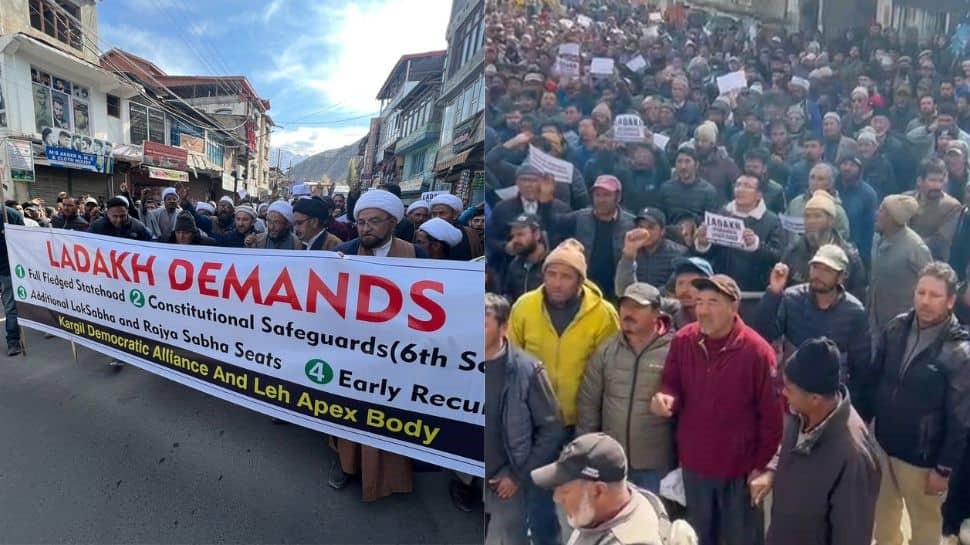Description

Disclaimer: Copyright infringement not intended.
Context
- The Leh Apex Body (LAB) and Kargil Democratic Alliance (KDA) called for a complete shutdown in Leh and Kargil districts of Ladakh on February 3.
- The movement seeks special rights for Ladakh after the region's separation from Jammu and Kashmir following the abrogation of Article 370.
Demands of the Movement:
- Restoration of statehood for Ladakh, which was changed to a Union territory without legislature on August 5, 2019.
- Tribal status for Ladakh, including its inclusion in the constitution's Sixth Schedule.
- Job reservation for locals and a parliamentary seat each for Leh and Kargil districts.
Background
- Ladakh became a Union Territory following the abrogation of Article 370 and the bifurcation of Jammu and Kashmir into two separate Union Territories in August 2019.
- Since then, the region has been advocating for greater autonomy and protection of its cultural and demographic identity.

Basic Demands:
- Statehood for Ladakh: Elevating Ladakh from its current Union Territory status to a full-fledged state, granting greater political autonomy and decision-making powers.
- Safeguards under the 6th Schedule: Constitutional provisions under the 6th Schedule to protect the cultural, linguistic, and land rights of the indigenous population.
- Reservation of Jobs: Reservations in employment opportunities for the youth of Ladakh, ensuring equitable access to economic resources and opportunities.
- Creation of Separate Parliamentary Constituencies: Establishment of distinct Parliamentary constituencies for Leh and Kargil, reflecting the unique demographic and geographical characteristics of each region.
Imperatives Behind Ladakh's Current UT Status
Cultural and Demographic Differences:
- Ladakh's Buddhist majority contrasted significantly with the Muslim-majority population of the erstwhile state of Jammu and Kashmir.
- This difference often translated into concerns about resource allocation, political representation, and cultural preservation.
Security Considerations:
- Ladakh borders sensitive regions like Pakistan and China, making strategic importance a significant factor.
- Establishing it as a union territory allowed for more direct and streamlined administration from the central government in security matters.
Developmental Perspective:
- The Indian government likely saw creating the union territory of Ladakh as a way to address long-standing grievances, improve administrative efficiency, and expedite development in the region.
Rationale for Statehood:
- Statehood would provide Ladakh with a more robust political framework to address its specific needs and challenges.
- It would empower the local population to have a greater say in decision-making processes that affect their lives and livelihoods.
Significance of Statehood:
- Statehood would enable Ladakh to have its own legislative assembly, allowing for laws tailored to the region's requirements.
- It would also lead to the development of a more comprehensive governance structure, enhancing administrative efficiency and responsiveness.
Way Forward:
- The central government must engage with the people of Ladakh in a meaningful dialogue to understand their aspirations and concerns regarding statehood.
- A comprehensive assessment of the implications of statehood, including economic, administrative, and social factors, should be conducted to inform decision-making.
|
Constitutional Provisions Related to Formation of States in India
Article 3 of the Indian Constitution:
- Grants Parliament the authority to undertake various actions regarding the formation, alteration, or dissolution of states.
- Actions include formation of new states, increase or decrease in state area, alteration of state boundaries, and change of state name.
Conditions under Article 3:
- A bill proposing changes must be introduced in either house of Parliament only with the prior recommendation of the President.
- Before recommending the bill, the President must refer it to the concerned state legislature to express its views within a specified period.
The Sixth Schedule
About:
- Contains special provisions for the administration of tribal areas in the four northeastern states of Assam, Meghalaya, Tripura, and Mizoram under Article 244(2) of the Indian Constitution.
- Aims to safeguard tribal land and resources, prevent their transfer to non-tribal entities, and protect tribal communities from exploitation.
|

|
PRACTICE QUESTION
Q. Discuss Ladakh's demand for statehood, including its primary demands and implications. Evaluate the factors contributing to this demand, its alignment with Ladakh's aspirations and the constitutional framework, and the challenges and opportunities associated with granting statehood to Ladakh.
|











